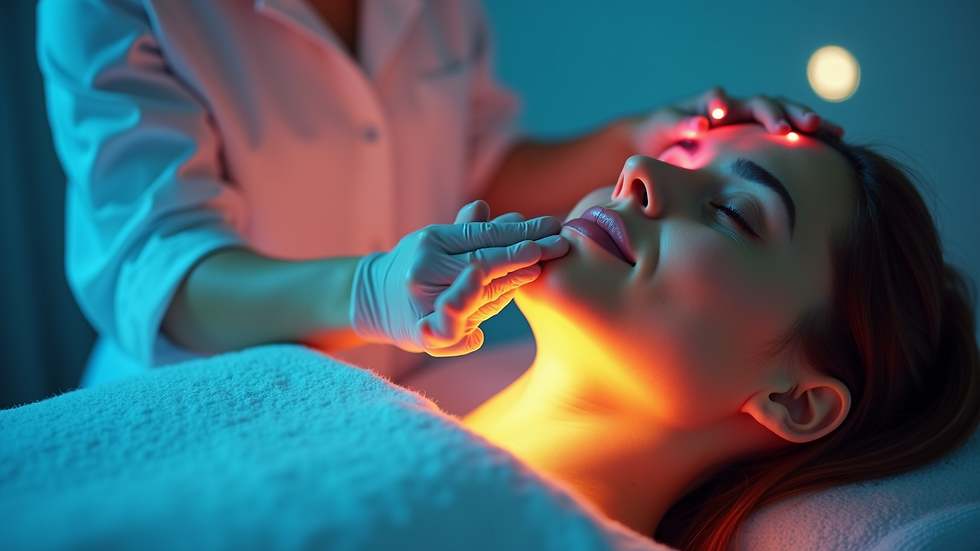The Role of Colors in Emotional and Physical Health
- divinetouchpune33

- Oct 28
- 4 min read
Colors surround us every day, influencing our moods, thoughts, and even physical well-being. The science and art of using colors to improve health and emotional balance is known as color therapy. This practice has been embraced in various cultures for centuries and is gaining renewed interest in modern wellness approaches. Understanding how colors affect us can empower us to create environments and habits that promote healing and happiness.
How Color Therapy Influences Emotional and Physical Health
Color therapy, also called chromotherapy, is based on the idea that different colors emit energy vibrations that can impact our body and mind. Each color corresponds to specific emotional and physical responses. For example, warm colors like red and orange can stimulate energy and passion, while cool colors like blue and green tend to calm and soothe.
Emotional Effects of Colors
Red: Often associated with excitement, passion, and energy. It can increase heart rate and stimulate adrenaline production.
Blue: Known for its calming effect, blue can reduce stress and promote relaxation.
Yellow: Linked to happiness and optimism, yellow can uplift mood and encourage creativity.
Green: Symbolizes balance and harmony, often used to reduce anxiety and promote healing.
Purple: Associated with spirituality and mindfulness, purple can encourage introspection and calm.
Physical Effects of Colors
Colors can also influence physical health by affecting hormone levels, blood pressure, and even pain perception. For instance, exposure to blue light has been shown to improve sleep quality by regulating melatonin production. Similarly, red light therapy is used in some treatments to stimulate circulation and tissue repair.

Practical Applications of Color Therapy
Incorporating color therapy into daily life can be simple and effective. Here are some actionable recommendations:
Home Decor: Use calming colors like soft blues and greens in bedrooms to promote restful sleep.
Workspaces: Bright yellows or oranges can boost creativity and energy.
Clothing Choices: Wearing colors that match your desired mood can influence your emotional state.
Lighting: Use colored light bulbs or filters to create specific atmospheres for relaxation or focus.
For those interested in deeper learning, exploring color therapy benefits through specialized courses can provide comprehensive knowledge and techniques.
Understanding Color Therapy: Origins and Modern Practices
Color therapy has roots in ancient civilizations such as Egypt, China, and India, where colors were used in healing rituals and spiritual practices. Today, it combines traditional wisdom with scientific research to offer holistic health solutions.
Historical Background
Ancient Egypt: Used colored stones and light to treat ailments.
Traditional Chinese Medicine: Linked colors to the five elements and organs.
Ayurveda: Emphasized the balance of colors in the environment and diet.
Modern Techniques
Light Therapy: Using colored light to treat conditions like Seasonal Affective Disorder (SAD).
Visualization: Guided imagery involving colors to reduce stress and enhance mental clarity.
Chakra Balancing: Aligning energy centers in the body with corresponding colors.
Benefits and Limitations
While color therapy is not a substitute for medical treatment, it can complement conventional therapies by enhancing mood, reducing anxiety, and supporting overall well-being. It is important to approach it as part of a balanced health regimen.

What is the Most Healing Color?
Among the spectrum of colors, green is often regarded as the most healing color. This is because green represents nature, growth, and balance. It is the color most associated with the heart chakra in energy healing traditions, symbolizing compassion and emotional equilibrium.
Why Green is Healing
Calming Effect: Green has a soothing impact on the nervous system, helping to reduce anxiety and stress.
Physical Healing: It is believed to promote recovery and regeneration in the body.
Mental Clarity: Green encourages a sense of renewal and mental freshness.
How to Use Green for Healing
Surround yourself with plants or green decor.
Wear green clothing when you need emotional support.
Use green light therapy sessions to enhance relaxation.
While green is widely recognized for its healing properties, the best color for healing can vary depending on individual needs and cultural contexts.
Practical Tips to Incorporate Color Therapy in Daily Life
Integrating color therapy into your routine can be both enjoyable and beneficial. Here are some practical ways to harness the power of colors:
1. Create a Colorful Morning Routine
Start your day by exposing yourself to energizing colors like yellow or orange. This can be through your clothing, breakfast tableware, or even a colorful workout space.
2. Use Colorful Foods
Eating a variety of colorful fruits and vegetables not only nourishes your body but also stimulates positive emotions. For example, red berries can energize, while leafy greens promote calm.
3. Design Your Environment
Choose paint colors and decorations that align with the mood you want to cultivate in each room. For example:
Living Room: Warm tones to encourage social interaction.
Bedroom: Cool tones for relaxation.
Office: Bright colors to enhance focus.
4. Practice Color Visualization
Spend a few minutes daily visualizing yourself surrounded by a healing color. Imagine the color enveloping you and bringing peace or energy as needed.
5. Experiment with Colored Lighting
Use smart bulbs or colored lamps to change the ambiance of your space according to your mood or activity.
By applying these tips, you can experience the subtle yet powerful effects of color therapy in your everyday life.
Exploring the Science Behind Color and Health
Scientific studies have begun to validate some of the claims of color therapy. Research in psychology and neuroscience shows that colors can influence brain activity, hormone levels, and emotional responses.
Psychological Studies
Colors like red can increase alertness and reaction times.
Blue environments have been linked to lower stress levels.
Yellow can improve memory and concentration.
Medical Applications
Light Therapy for SAD: Bright white and blue light exposure helps alleviate symptoms of seasonal depression.
Red Light Therapy: Used in dermatology and physical therapy to promote healing.
Limitations and Considerations
While promising, color therapy should be used thoughtfully. Individual reactions to colors can vary based on personal experiences and cultural backgrounds. It is essential to combine color therapy with other health practices for best results.
Colors are more than just visual stimuli - they are powerful tools that can influence our emotional and physical health. By understanding and applying the principles of color therapy, you can create environments and habits that support your well-being naturally and effectively. Whether through home decor, clothing, or light exposure, the right colors can help you feel balanced, energized, and healed.




Comments